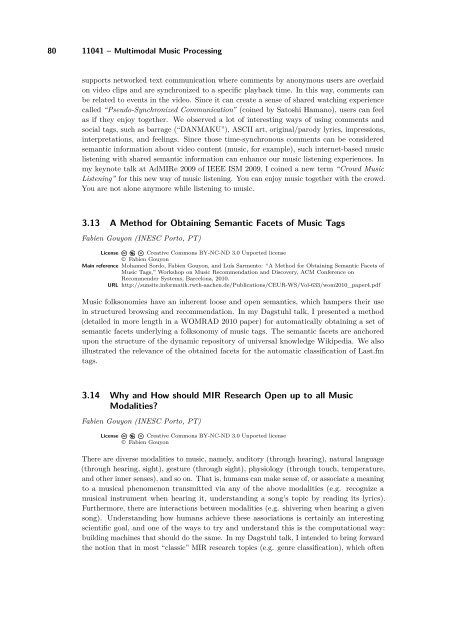Volume 1, Issue 1, January 2011 - DROPS - Schloss Dagstuhl
Volume 1, Issue 1, January 2011 - DROPS - Schloss Dagstuhl
Volume 1, Issue 1, January 2011 - DROPS - Schloss Dagstuhl
You also want an ePaper? Increase the reach of your titles
YUMPU automatically turns print PDFs into web optimized ePapers that Google loves.
80 11041 – Multimodal Music Processing<br />
supports networked text communication where comments by anonymous users are overlaid<br />
on video clips and are synchronized to a specific playback time. In this way, comments can<br />
be related to events in the video. Since it can create a sense of shared watching experience<br />
called “Pseudo-Synchronized Communication” (coined by Satoshi Hamano), users can feel<br />
as if they enjoy together. We observed a lot of interesting ways of using comments and<br />
social tags, such as barrage (“DANMAKU”), ASCII art, original/parody lyrics, impressions,<br />
interpretations, and feelings. Since those time-synchronous comments can be considered<br />
semantic information about video content (music, for example), such internet-based music<br />
listening with shared semantic information can enhance our music listening experiences. In<br />
my keynote talk at AdMIRe 2009 of IEEE ISM 2009, I coined a new term “Crowd Music<br />
Listening” for this new way of music listening. You can enjoy music together with the crowd.<br />
You are not alone anymore while listening to music.<br />
3.13 A Method for Obtaining Semantic Facets of Music Tags<br />
Fabien Gouyon (INESC Porto, PT)<br />
License Creative Commons BY-NC-ND 3.0 Unported license<br />
© Fabien Gouyon<br />
Main reference Mohamed Sordo, Fabien Gouyon, and Luís Sarmento: “A Method for Obtaining Semantic Facets of<br />
Music Tags,” Workshop on Music Recommendation and Discovery, ACM Conference on<br />
Recommender Systems, Barcelona, 2010.<br />
URL http://sunsite.informatik.rwth-aachen.de/Publications/CEUR-WS/Vol-633/wom2010_paper4.pdf<br />
Music folksonomies have an inherent loose and open semantics, which hampers their use<br />
in structured browsing and recommendation. In my <strong>Dagstuhl</strong> talk, I presented a method<br />
(detailed in more length in a WOMRAD 2010 paper) for automatically obtaining a set of<br />
semantic facets underlying a folksonomy of music tags. The semantic facets are anchored<br />
upon the structure of the dynamic repository of universal knowledge Wikipedia. We also<br />
illustrated the relevance of the obtained facets for the automatic classification of Last.fm<br />
tags.<br />
3.14 Why and How should MIR Research Open up to all Music<br />
Modalities?<br />
Fabien Gouyon (INESC Porto, PT)<br />
License Creative Commons BY-NC-ND 3.0 Unported license<br />
© Fabien Gouyon<br />
There are diverse modalities to music, namely, auditory (through hearing), natural language<br />
(through hearing, sight), gesture (through sight), physiology (through touch, temperature,<br />
and other inner senses), and so on. That is, humans can make sense of, or associate a meaning<br />
to a musical phenomenon transmitted via any of the above modalities (e.g. recognize a<br />
musical instrument when hearing it, understanding a song’s topic by reading its lyrics).<br />
Furthermore, there are interactions between modalities (e.g. shivering when hearing a given<br />
song). Understanding how humans achieve these associations is certainly an interesting<br />
scientific goal, and one of the ways to try and understand this is the computational way:<br />
building machines that should do the same. In my <strong>Dagstuhl</strong> talk, I intended to bring forward<br />
the notion that in most “classic” MIR research topics (e.g. genre classification), which often













